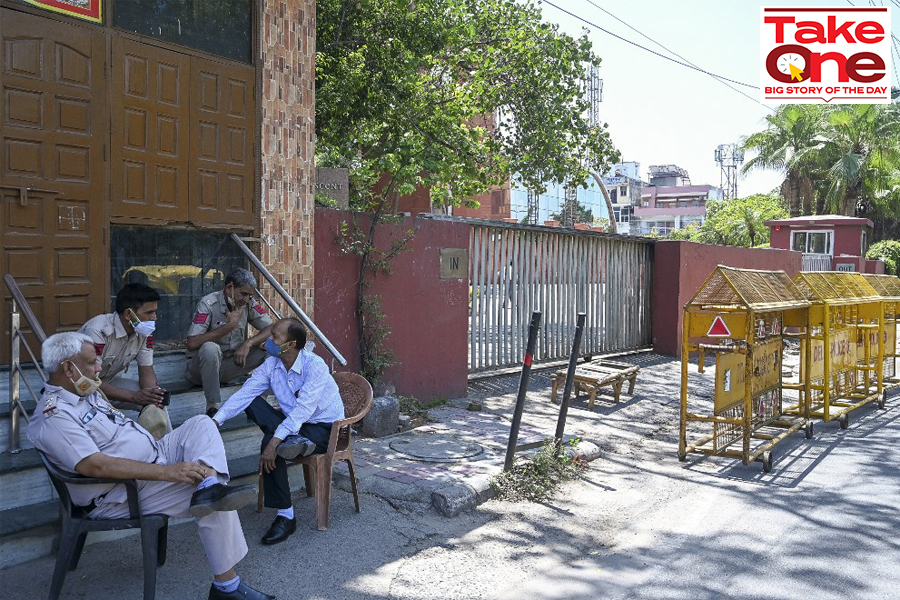
After pursuing terrorists, Delhi Police Special Cell investigates Twitter's 'manipulated media' policy
In the middle of a lockdown, Delhi Police's Special Cell turns up at the offices of social media platform Twitter in Delhi NCR to get "satisfactory" answers on its tweet labelling policy
 Delhi police personnel sit outside a gate of the Twitter India's office at Crescent building in New Delhi on May 25, 2021, as police served a notice at Twitter's offices over flagged governments tweets as 'manipulated media' a day before. Photo by Prakash SINGH / AFP
Delhi police personnel sit outside a gate of the Twitter India's office at Crescent building in New Delhi on May 25, 2021, as police served a notice at Twitter's offices over flagged governments tweets as 'manipulated media' a day before. Photo by Prakash SINGH / AFP
But on Monday night, the elite cell, whose official Twitter handle defines its job as to “prevent, detect and investigate cases of terrorism, organized crime and other serious crimes in Delhi”, descended on three Twitter offices in Delhi-NCR to investigate how Twitter labels manipulated media. The team was met with empty offices.
The Delhi Police’s Public Relations Officer Chinmoy Biswal told Forbes India that the police was there to serve a notice. Twitter has globally and publicly instituted a work from home policy amid the Covid-19 outbreak. When Forbes India asked Biswal how serving this notice at 8 pm in the middle of a pandemic-induced lockdown would help, he answered with a question—“Is there a lockdown for Delhi Police as well?”
Earlier on Monday, in response to a complaint filed by two Congress leaders on May 18, the Delhi Police had written to Twitter to seek information about its decision to label tweets by members of the Bharatiya Janata Party about an alleged toolkit created by the All India Congress Committee’s Research Department, as ‘Manipulated Media’. While fact checking platform Alt News debunked the toolkit claim, Twitter explains in a blog that the ‘manipulated media’ label is applied to media that is deceptively altered in any way or which deceives people about the origin of content.
What is the Manipulated Media tag?
In February 2020, to combat with misinformation, deepfakes ahead of the 2020 US Presidential election, Twitter announced that it would label tweets with synthetic and manipulated media (photos, videos) as “Manipulated Media” to provide more context. Twitter adopted a three-step test to ascertain whether or not it would label “manipulated media”. In cases where content is “significantly and deceptively altered or fabricated” and is shared in a deceptive manner (that is, it attempts to deceive people about the true origin or nature of the content) it is likely to be removed. In cases where such content might be affect public safety or cause serious harm, it may even be removed.
In June 2020, Twitter had labelled a tweet as having “manipulated media” by the then US President Donald Trump. On January 8, 2021, 12 days before Joseph Biden succeeded Trump, Twitter had permanently suspended the latter’s Twitter account citing “risk of further incitement of violence”.
In what was the first such label in India, Twitter labelled BJP IT Department’s Head Amit Malviya tweet as having “manipulated media” in December 2020.
What does the Delhi Policy Special Cell have to do with this?
But why is the Delhi Police, which falls under the Union Ministry of Home Affairs, investigating Twitter’s labelling policy?
“The reply that Twitter had sent was ambiguous. We wanted to ascertain who the right person is to whom the notice should be served,” Biswal told Forbes India. Did the agency figure out who the right person was? He said, “the investigating officer would know”. Neeraj Kumar, Special CP-Special Cell, refused to comment on the case, including divulging who the investigating officer of the case is.
Senior Advocate Vivek Sood told Forbes India, “In my view, the Delhi Police has no jurisdiction right now because Twitter has not committed any cognizable offence. Delhi Police, for obvious reasons, is trying to silence Twitter. It is a witch-hunt.”
Priyadarshi Banerjee, a Supreme Court lawyer who has represented Twitter in the past, called Delhi Police’s visit to Twitter’s Lado Sarai office (which is not Twitter’s registered office) nothing but a “shakedown” that was tantamount to “firing a cannon to kill a mosquito”, symptomatic of the trend the government has been veering towards the last few years.
On asking why the Special Cell was assigned this case, Biswal said, “We will ascertain these things during the investigation. Isn’t it too early to answer these questions?” In response to a Forbes India question about whether this inquiry is too minor for the Special Cell to undertake, he said that an inquiry can be assigned to any wing of the Delhi Police. However, he did not specify who assigned this case to the Special Cell.
A Twitter spokesperson declined to comment on the incident.
Which toolkit is this?
On May 18, an anonymous Twitter account, TEAM BHARAT (@TeamBharat_) tweeted screenshots from what it claimed was the “#CongressToolKit”. The screenshot of the alleged toolkit which has since been debunked, alludes that Indian Youth Congress’s efforts during the second wave of Covid-19 in March-April 2021 was a PR exercise “to contrast their work with apathy and inertia of the government as well as BJP’s organisation”. In an hour, BJP's National Spokesperson Sambit Patra had tweeted these screenshots along with multiple BJP functionaries and central government ministers (including Union Health Minister Harsh Vardhan). The hashtag #CongressToolKitExposed trended on Twitter India.
Alt News concluded that the document titled “Cornering Narendra Modi and BJP on COVID-19 mismanagement”, was forged since the letterhead did not match the one used by AICC’s Research department.
In a conversation with Forbes India, Rajeev Gowda, the Research Head of AICC, called this “toolkit hashtag movement… an attempt to divert from the devastation caused by the government’s mismanagement of the pandemic” and called it a “well-orchestrated conspiracy by the ruling party”. He said that the “forged document”, focussed on Covid-19 mismanagement, was displayed alongside a genuine internal document about the Central Vista project, which the BJP obtained via “illegal means”.
Twitter then slapped the “manipulated media” tag on Patra’s tweet, and on other similar tweets by BJP members, including Rajya Sabha Member of Parliament Vinay Sahasrabuddhe, BJP National Social Media Incharge Priti Gandhi, and others. The move led to the Ministry of Electronics and Information Technology (MeitY) swiftly instructing Twitter through “strong communication” to remove the tag. MeitY reportedly wrote to Twitter that since a law enforcement agency is investigating the issue, the platform cannot draw premature conclusions and “derail” it. Gowda and Rohan Gupta had filed a complaint with the Delhi Police on May 18 against Patra for “forging documents, and circulating fabricated material on Twitter”. "We received notice from Delhi Police on May 21 and replied on May 22," Gowda told Forbes India. He further said that if the case continues in Chhattisgarh, where an FIR has been filed against Patra and former Chief Minister Raman Singh and a notice has been issued, he would prefer it to continue there instead of having multiple cases on the same issue.
Gowda also accused the MeitY of attempting to “intimidate Twitter” into not “using its internal processes”.
“There is no government notice per se that we can see. It is all based on ‘sources’,” he said. Gowda remarked that the BJP has still not produced the alleged toolkit document in question and has only relied on screenshots.
On the basis of information available in the public domain about the case, Banerjee told Forbes India that a letter from MeitY does not suffice as a takedown order. Either the Ministry has treated the “manipulated media” tag as content in itself or as an implementation of its own community guidelines. In case it is the former, he said, the government can only go down the Section 69A blocking order route to order Twitter to take it down. In case it is treated as the latter, there is nothing in the Information Technology Act or the new Intermediary Rules that prevents intermediaries from implementing their own community guidelines.
Sood absolves Twitter even further. “Under the Indian Evidence Act of 1872, Twitter’s ‘manipulated media’ is only an evidentiary statement, an expert’s opinion which is admissible as evidence but is not conclusive. It has not adjudicated anything. Now, it is basically BJP versus Congress where Twitter is witness. Since it happened on Twitter’s platform, Twitter has the right to comment on it. It will be for the courts to decide whether Twitter’s opinion stands. It is up to BJP to cross-examine Twitter in the court of law and question its assessment,” he says.
The opacity around the government’s communication with Twitter has stumped legal experts. Multiple lawyers that Forbes India spoke to, who refused to go on the record fearing retribution, said that in the absence of clear details on what exactly is being investigated—the label or the document—and under which law, it is not clear if Twitter should have been served a notice at all.
Forbes India has reached out to Patra for a comment, and the story will be updated if a response is received.
The timing of the action, on the eve of the deadline of complying with India’s contentious new Intermediary Rules, casts a long shadow over how the current ruling dispensation views and governs free speech. A few days ago, on May 21, MeitY had directed all social media platforms to “immediately” remove all content that “names, refers to, or implies ‘Indian variant’” of Covid-19. Such advisories thwart multiple efforts—both genuine and otherwise—undertaken by social media companies to clean up their platforms.
Logical fallacies run abound in this case. If the Delhi Police is indeed investigating the allegedly forged document, it is not clear why they went to the Twitter office. “The content and who posted it are already there in the public domain. It is not clear what information the Delhi Police sought from Twitter,” Banerjee said.
After Twitter stood up to the government in February 2020 at the height of the farmer’s protests and refused to take action on accounts of news organisations, journalists, activists and politicians, IT Secretary Ajay Prakash Sawhney had, what seemed at that time, an inconclusive meeting with Twitter’s Vice President of Global Public Policy Monique Meche and Deputy General Counsel and Vice President Legal Jim Baker.
In a subsequent scathing press release, it appeared that Sawhney had spent much of the time reminding Twitter executives that while the platform is free to formulate its own rules and guidelines, as a business entity working in India, Indian laws must take precedence of its own internal rules and guidelines. However, Twitter had stuck to its guns and not removed the other accounts despite a Section 69A blocking order.
At that time too, a toolkit was at the centre of the debate—the one that environmental activist Greta Thunberg had tweeted about and which eventually led to the Delhi Police Special Cell arresting Indian climate activist Disha Ravi. She is now out on bail after having spent 10-days in police custody. MeitY had at that time cited the foreign origins of the toolkit as “misuse” of Twitter that aims to “create disharmony and unrest in India”.
Post Your Comment


















